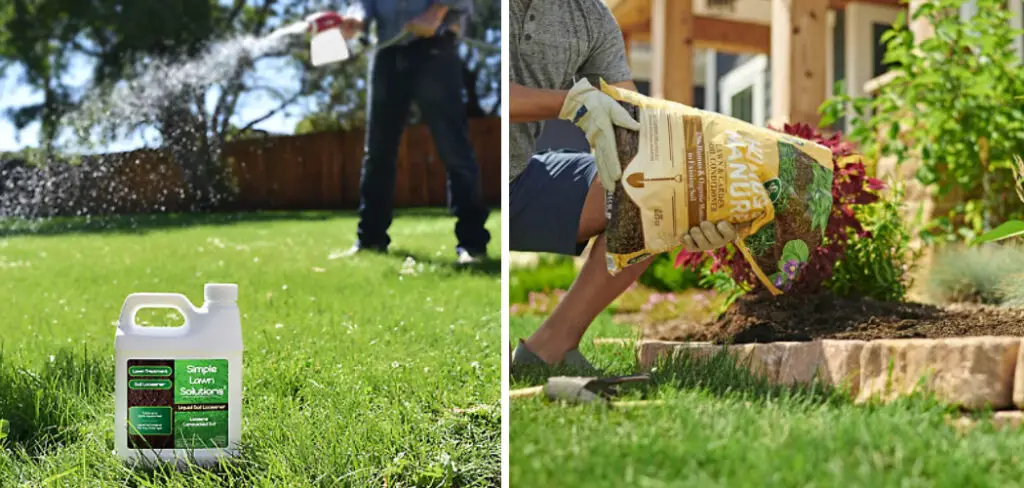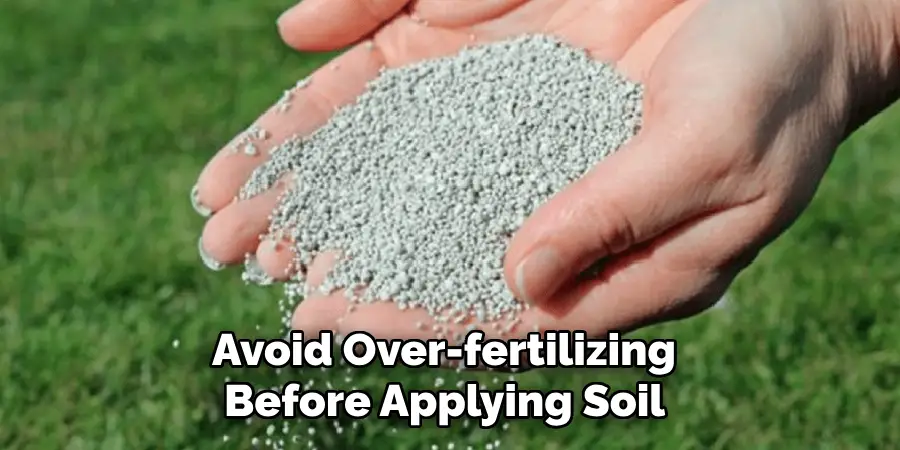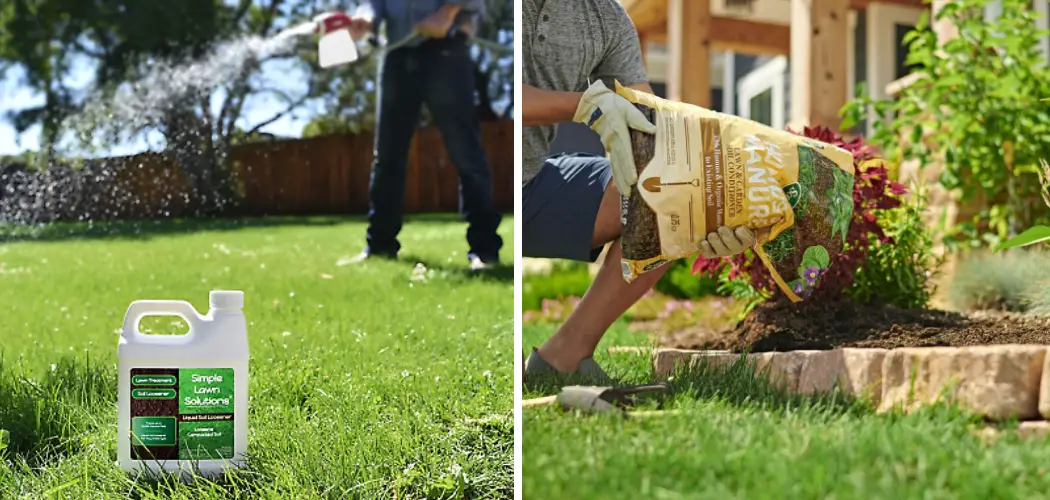Are you looking to give your lawn a healthy boost? Soil conditioners are often the secret ingredient for gardeners wanting to quickly improve their turf. From increasing soil-bearing capacity and nutrient availability to improving water drainage and aeration, soil conditioners can help bring life back into a lawn that appears dull or unhealthy. Here, we’ll explore how to apply soil conditioner to lawn to make your garden look lush and vibrant again!
If you’re looking for an easy and effective way to give your lawn a healthy boost, applying soil conditioner can be just what it needs. Whether you have a small lawn or acres of land, the benefits that come with using this product are undeniably worth it.
Soil conditioners increase organic matter in soils while boosting their ability to store moisture and nutrients, which helps promote better root growth and a healthier landscape overall.

Why May You Want to Apply Soil Conditioner to Lawn?
1 . To Improve Nutrients Retention
Soil conditioners are applied to lawn in order to improve the capacity of soil to retain nutrients. The conditioner, which can be organic or inorganic, helps to increase the cation exchange capacity (CEC) of the soil.
This means that it will better retain positively charged ions such as potassium, magnesium and calcium which are essential for plant growth. Without enough cations, plants will suffer from nutrient deficiency and show signs such as stunted growth and yellowing of leaves. By applying soil conditioner to lawn, you can ensure that your plants have access to the vital nutrients they need for healthy growth.
2 . To Enhance Soil Structure
Soil conditioners also play a crucial role in improving the structure of the soil. They are known to increase the amount of organic matter in the soil, which helps to create a more porous and loose texture. This in turn allows for better air circulation within the soil, promoting root growth and allowing water to penetrate deeper into the ground. A well-structured soil also prevents compaction, which can hinder root growth and nutrient absorption.
3 . To Balance Soil pH
Another reason to apply soil conditioner to lawn is to balance the pH level of the soil. Many plants thrive in a slightly acidic or neutral soil, but with constant use of fertilizers and other chemicals, soil pH can become too acidic or alkaline.
This can affect the availability of nutrients in the soil, making it difficult for plants to absorb them. Soil conditioners can help to buffer the pH of the soil, creating a more suitable environment for plant growth.
4 . To Improve Water Retention
Soil that is too sandy or clayey can have poor water retention capacity, leading to uneven moisture levels in the soil. This can result in drought stress or waterlogging for plants. user can help to improve the water-holding capacity of the soil, ensuring that it retains enough moisture for plants to thrive. This is especially beneficial during hot and dry weather conditions.

How to Apply Soil Conditioner to Lawn in 5 Easy Steps
Step 1: Prepare the Lawn
Before you can apply soil conditioner to your lawn, it’s important to prepare the area properly. Start by mowing your lawn to a short length and removing any debris or thatch. This will provide a clean surface for the conditioner to be applied.
Step 2: Test Your Soil pH Level
The next step is to test your soil’s pH level. This will determine the type of soil conditioner you need to use for your lawn. You can purchase a pH testing kit at any garden center or online.
Step 3: Choose the Right Soil Conditioner
Based on the results of your soil’s pH level, choose the appropriate soil conditioner for your lawn. Acidic soils typically require lime-based conditioners, while alkaline soils benefit from sulfur-based conditioners.
Step 4: Apply the Soil Conditioner
Using a spreader or by hand, evenly apply the soil conditioner to your lawn. Be sure to follow the manufacturer’s instructions for application rates and frequency. Also, take care to avoid overlapping areas as this can lead to uneven growth.
Step 5: Water Thoroughly
After application, water your lawn thoroughly. This will help the soil conditioner penetrate deep into the soil for maximum effectiveness. It’s also important to keep the lawn moist in the days following application to promote proper absorption.
Some Extra Tips to Apply Soil Conditioner to Lawn
1 . Do Not Apply Too Much Fertilizer Beforehand
It’s important to avoid over-fertilizing your lawn before applying a soil conditioner. This can cause nutrient imbalances and hinder the effectiveness of the conditioner. Also, avoid applying fertilizers and conditioners at the same time.

2 . Aerate Your Lawn
For best results, aerate your lawn before applying a soil conditioner. This will help loosen compacted soil and allow for better absorption of the conditioner.
3 . Use Organic Soil Conditioners
Organic soil conditioners are a more natural and environmentally friendly option for your lawn. They can also improve the overall health of the soil and promote better plant growth.
4 . Consider Using a Sprayer
If you have a large lawn, it may be more efficient to use a sprayer to apply the soil conditioner. This will help ensure an even application and save you time and effort. Also, be sure to clean the sprayer thoroughly after use to prevent clogs.

5 . Re-apply as Needed
Depending on the condition of your lawn and the type of soil conditioner used, you may need to reapply the product multiple times throughout the year. Follow the manufacturer’s recommendations for frequency and always monitor your lawn’s health for any signs of improvement or decline.
Frequently Asked Questions
What Precautions Should You Take When Applying Soil Conditioner to Your Lawn?
When applying soil conditioner to your lawn, there are a few precautions you should take to ensure the best results: Make sure the soil is not waterlogged or compacted before application. This can prevent the soil conditioner from penetrating deep into the soil.
Avoid applying during extreme weather conditions such as high heat or heavy rain, as this can also affect the absorption of the soil conditioner. Additionally, make sure to follow the manufacturer’s instructions and do not exceed the recommended amount.
Can You Apply Soil Conditioner to a Newly Seeded Lawn?
Yes, you can apply soil conditioner to a newly seeded lawn. In fact, it is highly recommended to do so in order to improve seed germination and root development. However, make sure to wait until the new grass has established itself before applying the soil conditioner. This usually takes about 2-3 months after seeding.
How Often Should You Apply Soil Conditioner to Your Lawn?
The frequency of soil conditioner application depends on the condition of your lawn. It is generally recommended to apply it once a year in the fall or spring. However, if your lawn is experiencing issues such as poor drainage or compacted soil, you may need to apply it more frequently.
Is Soil Conditioner Safe for Children and Pets?
Most soil conditioners are made from natural and organic materials, making them safe for children and pets. However, it is always best to read the label and follow the manufacturer’s instructions to ensure the safety of your loved ones. If you have any concerns, it is recommended to keep children and pets off the lawn for 24-48 hours after application.
What are Some Other Benefits of Using Soil Conditioner on Your Lawn?
Aside from improving soil quality, there are other benefits to using soil conditioner on your lawn. It can help reduce erosion, improve water retention, and promote a healthier root system for your grass. It can also aid in the breakdown of thatch and increase nutrient availability for your plants. Overall, using soil conditioner can greatly benefit the overall health and appearance of your lawn.

Can I Use Soil Conditioner on Any Type of Lawn?
Yes, soil conditioner can be used on any type of lawn, including cool-season and warm-season grasses. However, it is always recommended to test a small area first before applying it to your entire lawn. This can help determine if the soil conditioner will have any adverse effects on your specific type of grass.
Conclusion
Ultimately, when looking to apply soil conditioner to your lawn, it’s important to assess the condition of your soil and determine what kind of improvement your lawn could benefit from. Different types of soil conditioners can bring a variety of advantages, so opt for whichever is most suited to your own backyard garden.
Now you know how to apply soil conditioner to lawn! Just make sure you take the proper safety precautions: wear gloves and protective gear, use the mixture in low-traffic areas or isolated spots first to get an idea of how it affects the grass, and keep kids and pets away during application. Take these steps now, and you’ll be well on your way toward having beautiful green grass year after year!
About
Outdoor Fixes is a distinguished figure in the world of Diy design, with a decade of expertise creating innovative and sustainable Diy solutions.
His professional focus lies in merging traditional craftsmanship with modern manufacturing techniques,
fostering designs that are both practical and environmentally conscious. As the author of diy,
outdoorfixes delves into the art and science of outdoorfixes-making, inspiring artisans and industry professionals alike.
Education RMIT University
(Melbourne, Australia) Associate Degree in Design (Outdoor Fixes) Focus on sustainable design, industry-driven projects,
and practical craftsmanship. Gained hands-on experience with traditional and digital manufacturing tools, such as CAD and CNC software.
Nottingham Trent University
(United Kingdom) Bachelor’s in outdoorfixes.com and Product Design (Honors) Specialized in product design with a focus on blending creativity with production
techniques. Participated in industry projects, working with companies like John Lewis and Vitsoe to gain real-world insights.
Publications and Impact
In diy, Outdoor Fixes his insights on indoor design processes, materials, and strategies for efficient production.
His writing bridges the gap between artisan knowledge and modern industry needs, making it a must-read for both budding designers and seasoned professionals.

